| |
Easy to build high-quality PLL FM transmitter with typical output power of 5 W and no-tune design. The transmitter includes RDS/SCA input and Audio/MPX input with optional pre-emphasis. It can be used with or without stereo encoder. Tuning over the FM band is provided by two buttons that control dual-speed PLL. The transmitter can work also without the LCD display. Some experience with building devices of this kind are highly recommended.
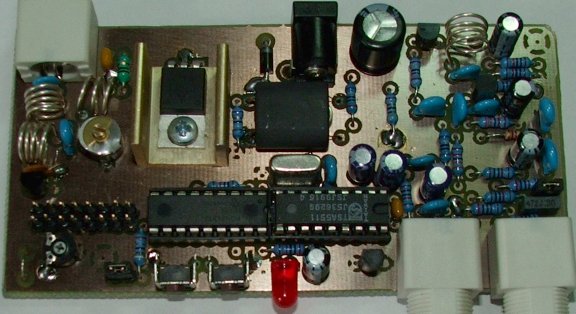
Characteristics
Supply voltage 11-13.8 V (stabilized or from a battery)
Supply current up to 1.2 A
Standard frequency range 87.5-107.9 MHz
Audio/MPX input sensitivity 2 V pp (for 75 kHz freq. deviation)
RDS/SCA input sensitivity 0.2 V pp (for 7.5 kHz freq. deviation)
Board dimensions 109 x 54 mm
Following table shows typical output power at 90 MHz for different power supply voltages and output stage transistors.
Supply voltage Single-sided PCB Double-sided PCB
2SC1971 2N3553 2SC1971 2N3553
12 V 4 W 1 W 5 W 1.5 W
13.8 V 5 W 1.5 W 7 W 2 W
Part list
Q1 - BF240
Q2 - BFG135 (BFG235)
Q3 - 2SC1971 (2N3553) + heatsink
Q4 - BC547B
D1 - SB260 (1N5822, 1N581x)
D2, D3 - BBY40 (BBY31)
D4 - LED 5mm
U1 - 78L09
U2 - TSA5511 (TSA5512, SDA3202) in DIL socket
U3 - PIC16F627A in DIL socket (programmed)
U4 - 78L05
R1, R2, R11, R17, R20 - 10k
R3, R21 - 270R
R4, R15 - 33k
R5, R7, R12, R13, R16 - 680R
R6, R14 - 18k
R8 - 47R (33R if Q2 is BFG235)
R9 - 18R
R10 - 4k7
R18 - 3k3
R19 - 100k smd 1206
R22 - 91R
R23 - trimmer 5k mini
C1, C4, C9, C12, C13, C14, C15, C30, C31, C32, C33, C35 - 10n smd 1206 (C)
C2, C17, C20 - 15p (C)
C3 - 10p (C) (15p if the PCB is single-sided)
C5 - 1n (C)
C6, C28, C29, C34 - 100u/10V (E)
C7, C26 - 10u/35V (E)
C8 - 22p (C)
C10 - 47p (C) (33p if Q3 is 2N3553)
C11, C27 - 100n (C)
C16, C36 - 33p (C)
C18 - cap. trimmer 50p
C19 - 470u/16V (E)
C21 - 4u7/50V (E)
C22 - 330p (C)
C23, C24 - 47p (C)
C25 - 3n3 (P)
L1 - 3.5 turns on 7 mm diameter
L2 - 1uH/815mA choke, or about 10 turns of thin wire on mini ferrite core
L3 - 2.5 turns on 6 mm diameter (4.5 turns if Q3 is 2N3553)
L4, L5 - 3.5 turns on 6 mm diameter
Y1 - crystal 6.4 MHz or 3.2 MHz
TR1 - rf ferrite transformer 2:1 (3:1 if Q3 is 2N3553), see text
SW1, SW2 - button mini
J1, J2, J3 - BNC connector 90 deg.
J4 - power supply connector
J5 - HD44780 LCD standard connector, 2x8 or 2x16 characters
J6, J7 - jumper
Additional information
For 0.05 MHz tuning step a 3.2 MHz crystal is required. In other case a 6.4 MHz crystal will make good work (tuning step 0.1 MHz). Any other crystal cannot be used.
Wind all coils (except the L2) by a 0.8 mm wire.
The Y1 package must be tied to ground!
Make sure the Q3 terminals are as short as possible (about 2-3 mm above board). The 2N3553 case/heatsink can't be tied to ground!
Be careful when soldering smd capacitors!
To make the TR1 transformer, use specified number of turns on primary side and one turn on secondary side. The secondary wire should be quite thick but the primary can be as thin as you want. Wind on a 2-hole ferrite (material 61 or N1). Alternatively use two ordinary ferrite beads placed side-by-side. Be careful when forming the 2SC1971 terminals - you may corrupt its internal structure! Or leave the terminals straight and use another suitable heatsink.
Control software for U3
The software for U3 is provided for download it below. Please read included license text first. Software modifications included: pll64.hex - 6.4 MHz crystal, pll32.hex - 3.2 MHz crystal, pll.asm - for any changes.
Fuses: WDT: Enabled, OSC: INTRC-I/O, MCLRE: I/O.
Use the buttons to set the frequency. After a few seconds of idle the frequency is tuned and stored to EEPROM (icon of diskette). Finally the buttons are locked (icon of key) to avoid unwanted frequency changes. Unlock by pressing any button for a longer time.
The display and LED indicate PLL in-lock state. This state is also provided at pin 1 of U3. It can be used for control of additional power amplifier. When in-lock state is indicated, the PLL is switched to low speed for maximally flat low audio frequencies response.
Placing in operation
tx4bulbs.jpg (16218 bytes)After complete parts placement:
Check that there are no shorts bridging adjacent tracks or pads.
Check electrolytic capacitors polarity and semiconductor parts orientation.
Make any duty load and connect it temporarily to the antenna connector. Use for example 2 or 3 bulbs (24V/170mA or 24V/3W) in parallel (see the picture).
Start with smaller power supply voltage, for example 9 V. The bulbs should glow a little. Then it's OK and you may increase the power supply voltage to 12 V. Adjust C18 to max. output power (impedance set). Adjust right LCD contrast by R23.
Now the L1 coil must be adjusted by stretching or compressing the turns. It affect frequency position of the band, which is the PLL able to tune.
Tune to 107.9 MHz using the buttons.
Measure tuning voltage at Q4 collector. Set the tuning voltage to 7.5 V by adjusting the L1.
Then you are done.
Now tune to 105 MHz and adjust C18 to max. power finally. At this point use about 10 meters of coaxial cable between the transmitter and the duty load!
If you have a problem with stability/spurious oscillations (very improbably if you used standard components and procedures), you may:
decrease R7 or R9 value
increase R8 value
decrease power supply voltage
use another material for TR1
If you want to change the output power, you may do it by changing the R8 value. Don't use smaller values than mentioned in part list!
PCB
You may choose between single-sided PCB (only bottom layer) and double-sided PCB (+ ground layer on the top). The difference is in output power. The double-sided PCB gives higher output power (this fact is not so interesting in rf issue).
The board dimensions are 109 x 54 mm. If double-sided PCB is used, don't forget to solder ground pins of key parts also from top side (mainly Q3, TR1, U1, D1, U4, SW1, SW2, R3, R8, C11).
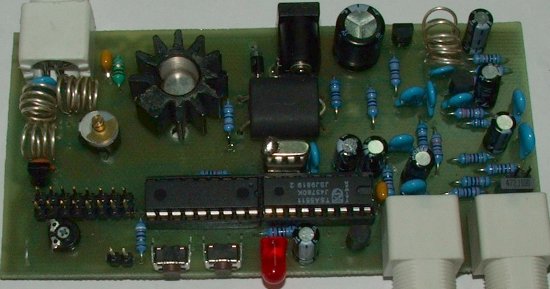
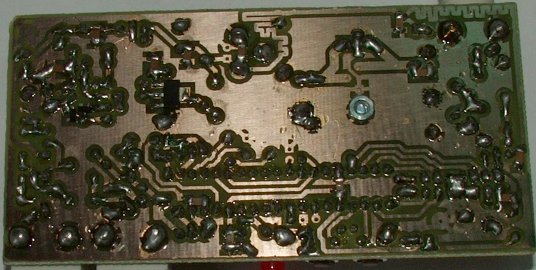
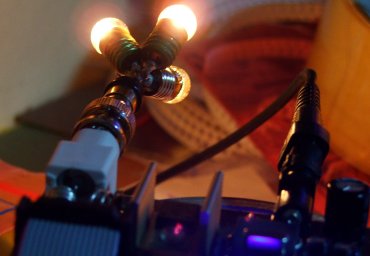
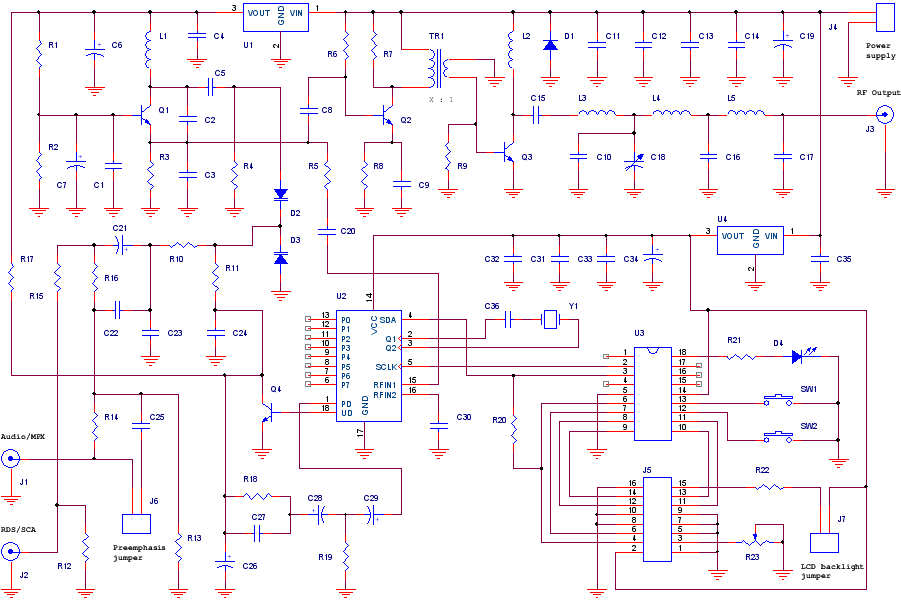
|
|
|
| |
Accurate LC Meter
Build your own Accurate LC Meter (Capacitance Inductance Meter) and start making your own coils and inductors. This LC Meter allows to measure incredibly small inductances making it perfect tool for making all types of RF coils and inductors. LC Meter can measure inductances starting from 10nH - 1000nH, 1uH - 1000uH, 1mH - 100mH and capacitances from 0.1pF up to 900nF. The circuit includes an auto ranging as well as reset switch and produces very accurate and stable readings. |
|
PIC Volt Ampere Meter
Volt Ampere Meter measures voltage of 0-70V or 0-500V with 100mV resolution and current consumption 0-10A or more with 10mA resolution. The meter is a perfect addition to any power supply, battery chargers and other electronic projects where voltage and current must be monitored. The meter uses PIC16F876A microcontroller with 16x2 backlighted LCD. |
|
|
|
60MHz Frequency Meter / Counter
Frequency Meter / Counter measures frequency from 10Hz to 60MHz with 10Hz resolution. It is a very useful bench test equipment for testing and finding out the frequency of various devices with unknown frequency such as oscillators, radio receivers, transmitters, function generators, crystals, etc. |
|
1Hz - 2MHz XR2206 Function Generator
1Hz - 2MHz XR2206 Function Generator produces high quality sine, square and triangle waveforms of high-stability and accuracy. The output waveforms can be both amplitude and frequency modulated. Output of 1Hz - 2MHz XR2206 Function Generator can be connected directly to 60MHz Counter for setting precise frequency output. |
|
|
|
BA1404 HI-FI Stereo FM Transmitter
Be "On Air" with your own radio station! BA1404 HI-FI Stereo FM Transmitter broadcasts high quality stereo signal in 88MHz - 108MHz FM band. It can be connected to any type of stereo audio source such as iPod, Computer, Laptop, CD Player, Walkman, Television, Satellite Receiver, Tape Deck or other stereo system to transmit stereo sound with excellent clarity throughout your home, office, yard or camp ground. |
|
USB IO Board
USB IO Board is a tiny spectacular little development board / parallel port replacement featuring PIC18F2455/PIC18F2550 microcontroller. USB IO Board is compatible with Windows / Mac OSX / Linux computers. When attached to Windows IO board will show up as RS232 COM port. You can control 16 individual microcontroller I/O pins by sending simple serial commands. USB IO Board is self-powered by USB port and can provide up to 500mA for electronic projects. USB IO Board is breadboard compatible. |
|
|
|
|
ESR Meter / Capacitance / Inductance / Transistor Tester Kit
ESR Meter kit is an amazing multimeter that measures ESR values, capacitance (100pF - 20,000uF), inductance, resistance (0.1 Ohm - 20 MOhm), tests many different types of transistors such as NPN, PNP, FETs, MOSFETs, Thyristors, SCRs, Triacs and many types of diodes. It also analyzes transistor's characteristics such as voltage and gain. It is an irreplaceable tool for troubleshooting and repairing electronic equipment by determining performance and health of electrolytic capacitors. Unlike other ESR Meters that only measure ESR value this one measures capacitor's ESR value as well as its capacitance all at the same time. |
|
Audiophile Headphone Amplifier Kit
Audiophile headphone amplifier kit includes high quality audio grade components such as Burr Brown OPA2134 opamp, ALPS volume control potentiometer, Ti TLE2426 rail splitter, Ultra-Low ESR 220uF/25V Panasonic FM filtering capacitors, High quality WIMA input and decoupling capacitors and Vishay Dale resistors. 8-DIP machined IC socket allows to swap OPA2134 with many other dual opamp chips such as OPA2132, OPA2227, OPA2228, dual OPA132, OPA627, etc. Headphone amplifier is small enough to fit in Altoids tin box, and thanks to low power consumption may be supplied from a single 9V battery. |
|
|
|
|
|
Arduino Prototype Kit
Arduino Prototype is a spectacular development board fully compatible with Arduino Pro. It's breadboard compatible so it can be plugged into a breadboard for quick prototyping, and it has VCC & GND power pins available on both sides of PCB. It's small, power efficient, yet customizable through onboard 2 x 7 perfboard that can be used for connecting various sensors and connectors. Arduino Prototype uses all standard through-hole components for easy construction, two of which are hidden underneath IC socket. Board features 28-PIN DIP IC socket, user replaceable ATmega328 microcontroller flashed with Arduino bootloader, 16MHz crystal resonator and a reset switch. It has 14 digital input/output pins (0-13) of which 6 can be used as PWM outputs and 6 analog inputs (A0-A5). Arduino sketches are uploaded through any USB-Serial adapter connected to 6-PIN ICSP female header. Board is supplied by 2-5V voltage and may be powered by a battery such as Lithium Ion cell, two AA cells, external power supply or USB power adapter. |
|
200m 4-Channel 433MHz Wireless RF Remote Control
Having the ability to control various appliances inside or outside of your house wirelessly is a huge convenience, and can make your life much easier and fun. RF remote control provides long range of up to 200m / 650ft and can find many uses for controlling different devices, and it works even through the walls. You can control lights, fans, AC system, computer, printer, amplifier, robots, garage door, security systems, motor-driven curtains, motorized window blinds, door locks, sprinklers, motorized projection screens and anything else you can think of. |
|
|
|